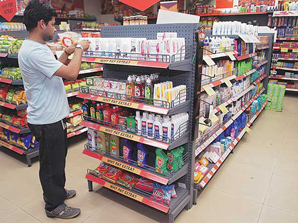New a/c rules to hit FMCG firms' revenues
August 29, 2016
Switch to Ind-AS standards reclassifies many items; margins could also take a hit
 Ind-AS, the new accounting standards that came into effect from April 1, might squeeze the revenues of fast moving consumer goods (FMCG) companies by up to eight per cent in 2016-17.
Ind-AS, the new accounting standards that came into effect from April 1, might squeeze the revenues of fast moving consumer goods (FMCG) companies by up to eight per cent in 2016-17.The key cause is deduction of sales promotion expenditure from the revenue figure, hitherto part of the profit & loss (P&L) statement under the earlier IGAAP accounting norms.
In the just-concluded June quarter, for instance, the top line of the country's largest consumer goods company, Hindustan Unilever (HUL), was affected by 2.6 per cent or Rs 214 crore under Ind-AS. Godrej Consumer Products' revenue was squeezed 10.4 per cent.
Sunil Duggal, chief executive, Dabur India, said six to seven per cent of its FY17 revenue would be hit. "Some part of promotional expenditure, mainly below-line expenses, will be deducted from revenue, expected to be around Rs 600 crore,†he said.
Vivek Karve, chief financial officer, Marico, said: "On an annualised basis, sales will get restated downwards by approximately Rs 100 crore under Ind-AS. But, as the previous year's numbers are also restated, there is hardly any impact on year-on-year growth.â€
At a time when companies are struggling to improve revenue growth, a readjustment of expenses in the P&L statement hardly bodes well for them, sector experts said. Many see an impact on margins, both operating and net.
Companies are also studying the possibility of contract manufacturing being considered as a finance lease, as opposed to an operating expenditure, under Ind-AS. This is key since most FMCG firms have opted to have an asset-light strategy, choosing to outsource manufacturing to third-party entities. Experts say there might have to be a re-look at strategy.
Rajiv Shah, director, S R Batliboi & Co, an accounting company, says: "As a finance lease, companies will be expected to record the assets of the contract manufacturer as their own in their books of account. They will not be comfortable doing so. Under Ind-AS, the assumption is if the contract manufacturer is working exclusively for the company, with dedicated facilities and volume commitments, then it should be considered a lease and accounted for appropriately.â€
Ind-AS will also impact employee stock option plans. These will now have to be recorded on a fair-value basis, resulting in compensation coming as a part of employee cost in the P&L statement. "This will result in additional notional charge to P&L impacting profits. This might, therefore, not be an incentive for companies and they are likely to look at alternative forms of rewarding employees,†said Shah.
CAUSE FOR CONCERN
- Reported revenue might come down by up to 8%, depending on promotional costs, trade incentives and discounts
- M&As might affect profit margins; high dependence on co-packers might increase liabilities
- During the April-June quarter, HUL's net sales restated by 2.6%, GCPL's by 10.4%
- Firms might reduce employee stock ownership plans as it will add to their employee costs from now on
Advertisement








